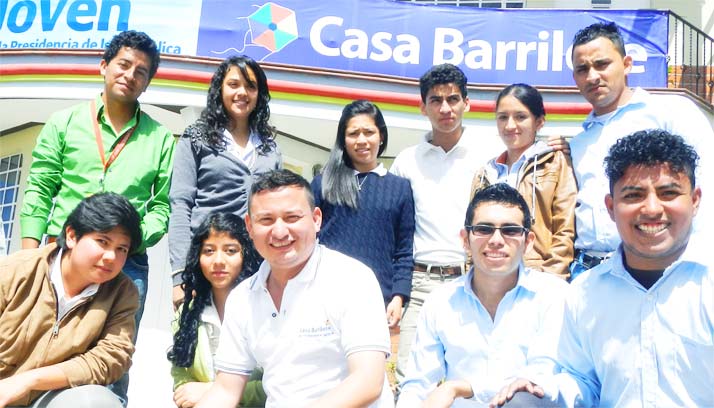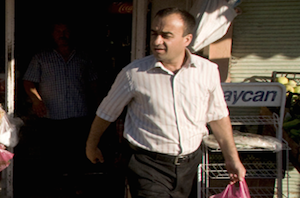 by Anthony Luberto
by Anthony Luberto
Living and working in Texas, it’s hard to ignore the humanitarian crisis of unaccompanied children entering the United States from Central America. Arriving tired and often without adequate food and water for weeks, it is a hotly contested debate in the U.S. and even more so now since President Obama recently signed an Executive Order temporarily allowing legal status to millions of illegal immigrants.
As I listened to media stories about masses of children arriving from Central America hungry, thirsty, and without their family, I could not help but feel compassion for them and wondered could I possibly help? What is going on in Central America and why are families there going through such lengths with sometimes tragic results, to get their children to the U.S.? Then it dawned on me, I was inundated with information about what is being done to protect the American border but I had personally never heard about what is being done internally within El Salvador, Honduras or Guatemala to prevent them from coming here. I began asking myself, what is happening in the development arena that helps prevent families from making the decision to send their children thousands of miles to the unknown? I wanted to know, so I began digging into Guatemala development efforts and more specifically the U.S. Agency for International Development (USAID).
Rather than float statistics and what different agencies say about the subject, I want to give the Global South Development Magazine readership a first-hand account of what I observed in development during my recent visit to Guatemala. Plain and simple, crime, poor education, lack of interest in the future, and love of country is NOT what I saw. In fact, the USAID team in Guatemala and the wonderful people I observed and talked to provided me a beautiful glimpse into the potential of a bright future. Yes, gangs do exist and yes, many development areas are flickering but there is also hard work being done to curb the future of Guatemala from draining away to the U.S.
SCHOOL HELPING PREVENT CRIME
The first day on the ground, I took a short but curvy ride to Palencia, a small town just northeast of Guatemala City, in search of any current or past USAID project. A town once plagued with crime, drugs, and gangs, Palencia is turning the tide with the help of an expired USAID but a self-sustained project. I was ecstatic when a young Palencia City Hall employee, Shirley Ramirez, walked me down an alleyway to a tucked-away little two-story school, the Casa Barrilete. Located in a former gang neighborhood and sitting atop a steep hill with picturesque views, Casa Barrilete is very well alive and vibrant with students, staff, and learning. For three years, the school thrived under the umbrella of USAID funding but unfortunately, some courses went away when the project ended and the Palencia City Hall began funding the school in the middle of 2014.
However, to my surprise, the school continues to function and keep children away from crime by providing formal and hands-on instruction in computer skills, art, music, and television production. Orien Siguenza Quezada, a boyish 26-year-old computer skills teacher, believes he makes a difference to the country but also understands the “country must invest in education,” if children are to remain and not head for the U.S. The inner workings of the school are truly encouraging. There are 25 computers on-site where students can take 128 hours of Windows courses and another 128 hours of advanced learning. Students have the opportunity to learn drums, the xylophone, or paint a vivid picture expressing their innermost thoughts or troubles. City Hall evens lends a hand by allowing the school to use their bus one day a month to teach subjects to communities in the outlying areas of Palencia.
As I finished walking around Casa Barrilete, Juan de Dios Pineda Castro, the Director of Casa Barrilete, and I walked outside where three boys casually played with some local cows. We talked about our families for a minute and then on to a deeper discussion and his views about what is going on in Guatemala and what help is needed. “Children leave for three reasons,” he explained, “1) One of the parents is already in the U.S wanting the child or children with them, 2) There are no job opportunities for children between 13-17 years old and; 3) Violence inside and outside the family.” He’s trying to change those trends by handing out flyers and encouraging the community he’s lived in his entire life to come to Casa Barrilete and learn the skills necessary for a successful life. He then said to me, “we have a class on immigration to the states next week,” which caught my interest. Before I knew it, he was on the phone and I was on my way to the local World Vision office in Guatemala City.
WORLD VISION IN GUATEMALA
The immigration class Juan referred to turned out to be much deeper in scope than I anticipated when I arrived at the World Vision office. Arriving unannounced but inquisitive about the program, Monica Ramirez, the Christian Commitment Manager and 15-year World Vision employee, set me straight. She explained, “We are focused on causes…immigration is a result.” Principally, World Vision believes violence to children is one of the main root causes to children leaving the country and protection from physical abuse, drugs and alcohol, and sexual abuse can help keep them in Guatemala. With a massive reach all over the country, World Vision provides a simple course to over 274 schools and 50,000 children designed to educate them about children protection. Its premise is simple, but the long-term benefits could help shift the thought process behind the meaning of family therefore decreasing the need to leave the country. Focusing immediately on the Western Highlands of Guatemala, where the challenge is most prevalent, specific topics taught to children include:
1- Overall respect for God,
2The rights and obligations of parents (my family takes care of me),
3-The rights and obligations of the community (my community takes care of my family),
4-Self-worth (I take care of myself and know what is not right…sexual abuse),
5- And the risks associated with leaving all of these behind (immigrating to the U.S.)
RURAL VALUE CHAIN: AGEXPORT
The lack of job opportunities not only contributes to a poor economy in Guatemala but also to visions of available opportunities in the U.S. I wanted to know from USAID what they were doing in this particular arena to help. The USAID Guatemala team linked me in with one of their implementing partners of a rural value chain project, AGEXPORT to find out. The overall goal of AGEXPORT is to consolidate small farmers and their products, provide technical assistance where necessary, and get those products to a standard where they are exportable to markets worldwide. To see an example of this process, AGEXPORT took me out to Sololá, a small farming town near Lago de Atitlán about two hours west of Guatemala City. Upon arrival, Mr. Juan Tuis Tuy, the President of the local Adiba, greeted me with a smile and handshake. I was curious how the whole process worked, his role within it and how it contributed to the overall economic improvement of Guatemala. He and his team of managers explained to me as simply as they could.
AGEXPORT provides the program management of 31 separate Adibas throughout the country. Not all Adibas are of the same size, scope, or product but they all act as regional consolidation management points of small local farmers and their products. Adibas consolidate, classify, and separate the products and then turn them over to Siesa who exports the product to foreign markets including England and the U.S. Not all farmers, but small farm leaders get their quality certification through the Global Agricultural Practice (GAP), which certifies that their farming practices and procedures are following global set standards. The extra bonus is that it allows their products to access U.S. and other foreign markets. On Mr. Tuy’s Adiba, there are 160 GAP certified farmers who employ over 16,000 additional farmers. In 2015, he anticipates employing more women and is proud to say that 95% of his farmers can read and write. Why isn’t this model being replicated throughout the country in order to prevent unaccompanied children from going to the U.S.?
After talking through the processes, actors, and getting to know one another Mr. Tuy offered to take me to one small area of his 41-acre Adiba that produces sweet peas. As we walked or more like crawled up the side of a small mountain, he informed me that his particular Adiba produces over 800,000 pounds of sweet peas for the U.S., Canada the European Union and England. Turning around and looking at all of the sweet peas behind us and the view of a volcano in the distance, I turned to him and said “Mr. Tuy, this is the most beautiful view I’ve ever seen in my entire life and I thank you for that.” I told him that I would go back home and help promote his story and the stories of farmers like him. I would tell people that there are citizens of Guatemala who ARE hard at work, who do CARE about their families, who do BELIEVE in the future of their country, who want to SUCCEED in life and not get into crime. We shook hands, hugged and I took the long drive back to my hotel deep in thought.
It was evident to me during my time in Guatemala that there is strong potential in the future and children must stay put and not take the treacherous journey to the United States where the journey alone might kill them. There is a future in Guatemala and there are bright spots all over the country that highlight that future. Children are interested in education, farmers and businesses alike are looking to get their products to global consumers. Guatemalans must not give up on Guatemala but they cannot be alone in that endeavor. International organizations and foreign governments must assist and provide adequate resources to areas of the world that need development. Guatemala is no exception. As the U.S. comes out of conflict, it must shift its funding and resources to diplomacy and development in countries that are promoting democracy and have potential like Guatemala.
Thousands of unaccompanied children are headed to the U.S. as we speak because of one of the reasons mentioned throughout this article. If the U.S. or any other developed country wants to end the humanitarian crisis of unaccompanied children entering its borders then perhaps they should seriously consider investing more resources into USAID and their projects. Projects like AGEXPORT and Casa Barrilete are rare because not enough funding and resources are allocated to USAID or other organizations to help. However, these types of projects actually work and are preventing crime, educating the future, and helping to create a sustainable economy.











